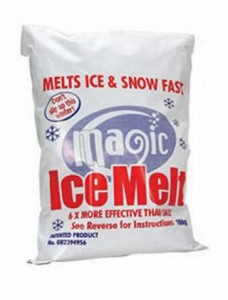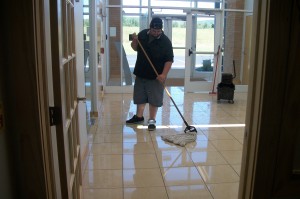 In the harsh winter months facility managers are faced with the extra task of dealing with icy walkways and the interior mess caused by ice melting products. Homeowners too struggle with many of the same dilemmas. Ignoring the slick surfaces can lead to legal action and injury. Dealing with the ice can potentially cause damage to carpets, wood floors, metal sills and the outdoor walkways themselves. They can also be harmful to pets, animals and vegetation. A good start to any winter maintenance program is a general understanding of the various types of deicing compounds.
In the harsh winter months facility managers are faced with the extra task of dealing with icy walkways and the interior mess caused by ice melting products. Homeowners too struggle with many of the same dilemmas. Ignoring the slick surfaces can lead to legal action and injury. Dealing with the ice can potentially cause damage to carpets, wood floors, metal sills and the outdoor walkways themselves. They can also be harmful to pets, animals and vegetation. A good start to any winter maintenance program is a general understanding of the various types of deicing compounds.
Though many brands of ice melts are available on the market today, there are basically only two main types. One type is chlorides and they contain some type of salt. The other type is urea, also known as carbamide, usually found in animal feed and fertilizers. Each has its own pros and cons and careful consideration should be taken to choose the one that best fits your particular application.
- Sodium Chloride – sometimes referred to as Rock Salt or Halite, it can be quite destructive to a variety of building materials. With limited effectiveness below 20°F, splintering to wood floors and dry rot to carpets and rugs are common problems along with hazy white stains. It can also cause corrosion to steel and damage concrete and vegetation.
- Calcium Chloride – similar to sodium chloride but effective to -25°F, this compound can leave oily residues that attract excess soil on carpets and make smooth surfaces such as VCT and ceramic tiles slippery. It can also cause damage to vegetation and the wax and urethane finishes on wood floors.
- Potassium Chloride – although it may be used in fertilizers, the concentrations used in ice melt products are not necessarily safe for plants and landscaping. Good to about 12°F it is less corrosive than other products and effective at preventing icy buildup on walkways.
- Magnesium Chloride – effective to -5°F, safer for vegetation, less corrosive and less harmful to concrete. However after a short period of time it usually loses its ice melting capability calling for additional applications where there are larger amounts of snow and ice.
- Urea – effective to about 15°F and a safer and less corrosive way to melt ice and snow. It also provides nitrogen to plant roots although run off into waterways may cause issues. Some urea based deicers are susceptible to caking both during storage and after application, making cleanup more difficult.
 When trying to prevent damage to carpets, wood floors, rugs and other floor surfaces, regular and frequent cleaning is important. Wet mopping with a mildly acidic detergent can help neutralize any residues. For stained and soiled carpet your local professional carpet cleaner can assist in stain removal. A comprehensive walk off mat program can aide in containing the spread of tracked in soils. According to the Dow Chemical Corporation using more than called for does not do a better job. Avoid excess application of deicers as more is not better and always follow the product recommendations listed on the container.
When trying to prevent damage to carpets, wood floors, rugs and other floor surfaces, regular and frequent cleaning is important. Wet mopping with a mildly acidic detergent can help neutralize any residues. For stained and soiled carpet your local professional carpet cleaner can assist in stain removal. A comprehensive walk off mat program can aide in containing the spread of tracked in soils. According to the Dow Chemical Corporation using more than called for does not do a better job. Avoid excess application of deicers as more is not better and always follow the product recommendations listed on the container.
